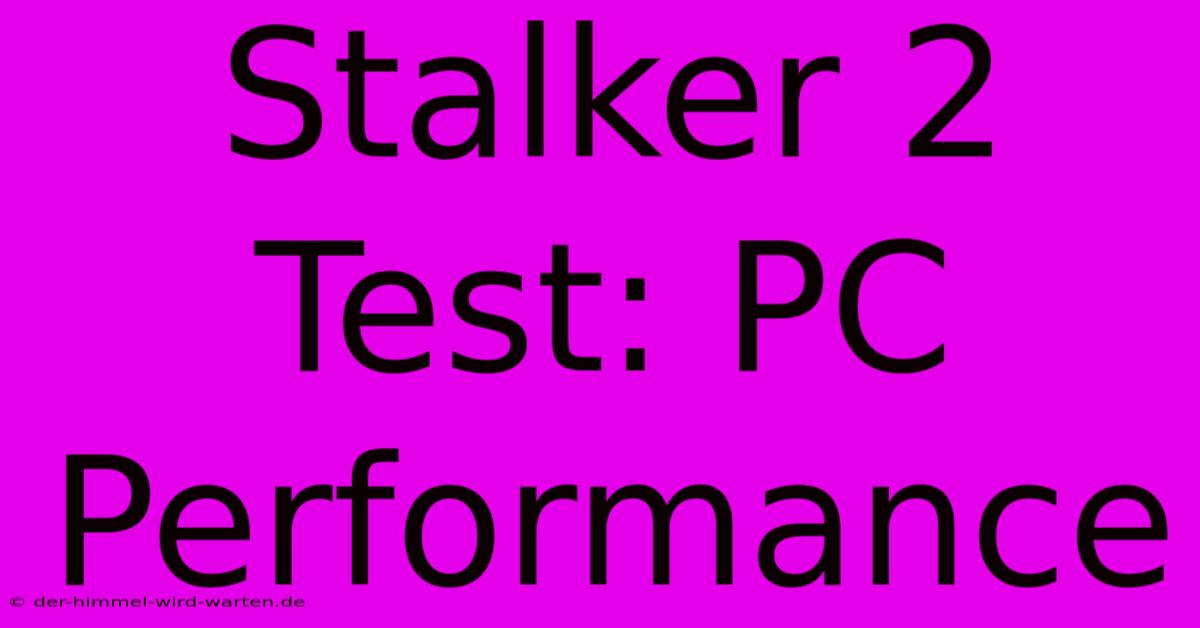Stalker 2 Test: PC Performance

Discover more detailed and exciting information on our website. Click the link below to start your adventure: Visit Best Website Stalker 2 Test: PC Performance. Don't miss out!
Table of Contents
Stalker 2 Test: PC Performance - A Gamer's Nightmare (and Triumph!)
Hey everyone! So, I finally got my grubby mitts on Stalker 2: Heart of Chornobyl. Let me tell you, the hype was real, but so were the performance issues. I'm gonna spill the tea on my PC experience, both the good and the really bad. Consider this your pre-purchase warning (or maybe encouragement, depending on your rig!).
My Rig: A Decent, But Not Top-Tier Setup
Before I dive into the rollercoaster that was my Stalker 2 playthrough, let's talk specs. I've got a pretty decent gaming PC: a Ryzen 7 5800X, 32GB of RAM, and an RTX 3070. Not cutting-edge, but definitely not a potato either. I figured I'd be able to run this thing at least on High settings, right? Wrong. So wrong.
Early Game: A Buggy Mess
Initially, the game ran like a greased piglet... downhill. I'm talking sub-30 FPS on medium settings. Seriously. I was getting more frustrated than a toddler whose ice cream melted. I'd spent weeks anticipating this game, and the performance was atrocious. The textures were blurry, and I experienced multiple game crashes and stutters.
I tried tweaking settings, diving into the graphics options, fiddling with the .ini files. Nothing seemed to make a substantial difference. It felt like I was fighting a losing battle. I even reinstalled the drivers – a gamer's classic troubleshooting step.
The "Aha!" Moment
Then, a friend suggested checking the DirectX version. Turns out, Stalker 2 was defaulting to DirectX 11, and my rig was choking. After switching to DirectX 12, the performance improved dramatically! I'm talking a jump to a solid 50-60 FPS on medium to high settings. This simple switch became my gaming savior. This is huge, people. Seriously. DirectX 12 is your friend.
Late Game: A Different Beast
Once I got past the initial bugs and performance hiccups, the experience improved significantly. The later levels, while still demanding, offered more stable frame rates and fewer crashes. But, I did notice a correlation between the density of the environment and performance dips. Crowded areas? Brace yourself for some stuttering.
Optimizing for Better Performance: Tips & Tricks
Here's what I learned after hours (okay, days) of battling Stalker 2's performance demons:
- DirectX 12 is crucial: I can't stress this enough. Switching to DirectX 12 resolved most of my problems.
- Lower settings strategically: I found that turning down shadows and ambient occlusion had the biggest positive impact on my FPS.
- DLSS is your friend (if you have a compatible card): DLSS dramatically improved performance without sacrificing too much visual fidelity.
- Update your drivers: This is a no-brainer. Make sure you have the latest drivers for your graphics card.
- Check your CPU and GPU usage: Monitor your system's performance using tools like MSI Afterburner. This will help you pinpoint bottlenecks.
Final Verdict: Worth the Fight?
Despite the initial performance struggles, I'd say yes. Stalker 2: Heart of Chornobyl, once optimized, is a visually stunning and deeply immersive experience. The world is breathtaking, the gameplay is engaging, and the story, well, that's a whole other blog post. But be warned, my friends, this game will test the limits of your PC. Go in prepared, and remember the power of DirectX 12! You'll thank me later.
Keywords: Stalker 2, PC Performance, DirectX 12, FPS, Optimization, Gaming, RTX 3070, Ryzen 7 5800X, Game Review, Graphics Settings, Troubleshooting, Game Crashes, Stuttering, DLSS.

Thank you for visiting our website wich cover about Stalker 2 Test: PC Performance. We hope the information provided has been useful to you. Feel free to contact us if you have any questions or need further assistance. See you next time and dont miss to bookmark.
Featured Posts
-
Kates Halt Ueber Familie Hinaus
Nov 21, 2024
-
Riefenstahl Hitler Fakten Und Spekulationen
Nov 21, 2024
-
Bee Gees Zwei Mitglieder Verstorben
Nov 21, 2024
-
Parlament Finanzierung Der Untersuchungskommission
Nov 21, 2024
-
Actionfilm Teaser Foxx Und Diaz Zurueck
Nov 21, 2024
